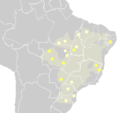Krahô (Krahô: Mehĩ jarkwa [mẽˈhĩ jaɾˈkʰwa]: 74 ) is a dialect of the Canela-Krahô language, a Timbira variety of the Northern Jê language group (Jê, Macro-Jê)...
3 KB (128 words) - 20:09, 28 October 2023
Jê Southern Jê (dialect continuum) Ingain ↔ Xokleng ↔ Kaigáng Northern Jê Jê proper (Timbira-Kayapó dialect continuum) Canela-Krahô ↔ Gavião-Krĩkati...
28 KB (535 words) - 20:41, 28 August 2023
Timbira language (redirect from Canela-Krahô language)
to sometimes be considered separate languages. The principal varieties, Krahô /ˈkrɑːhoʊ/ (Craó), and Canela /kæˈnɛlə/ (Kanela), have 2000 speakers apiece...
6 KB (522 words) - 20:40, 28 August 2023
Canela is a dialect of the Canela-Krahô language, a Timbira variety of the Northern Jê language group (Jê, Macro-Jê) spoken by the Apànjêkra (Apaniêkrá)...
30 KB (1,607 words) - 22:59, 12 February 2024
and Proto-Northern Jê *a-mbə ‘eat (intransitive)’ (as preserved in Canela/Krahô/Parkatêjê apà, Pykobjê aapỳ, Panará -ânpâ) with Proto-Trans-Tocantins *ap-ku...
3 KB (202 words) - 19:15, 3 October 2023
pre-contact Mocoví and Pilagá, Culina and pre-contact Jarawara, Jabutí, Canela-Krahô, Botocudo (Krenák), Chiquitano, the Campa languages, Arabela, and Achuar...
58 KB (3,588 words) - 16:32, 30 August 2024
of the Karajá people. Examples include warikoko (Kayapó dialect) or watkoko (Xikrin dialect) 'tobacco pipe', rara 'kind of basket', wiwi 'song, chant'...
19 KB (1,604 words) - 17:36, 5 January 2024
to be associated with shared ancestry, history, homeland, language or dialect and cultural heritage; where the term "culture" specifically includes aspects...
418 KB (3,623 words) - 03:31, 5 November 2024
(wapishana) Cantá, Roraima (macushi) and (wapishana) Itacajá, Tocantins (Krahô) Tocantínia, Tocantins (Xerénte) Municipalities that have co-official Italian...
119 KB (9,286 words) - 00:50, 5 November 2024
branch of the Jê languages constituted by the Timbira dialect continuum (which includes Canela, Krahô, Pykobjê, Krikati, Parkatêjê, and Kỳikatêjê) and a...
45 KB (3,174 words) - 03:55, 6 January 2024
(Cayapo, Mebêngôkre), Mato Grosso and Pará Laklãnõ, Santa Catarina Mehim (Krahô, Crahao), Rio Tocantins Ofayé, Mato Grosso do Sul Parakatêjê (Gavião), Pará...
110 KB (9,031 words) - 10:54, 21 October 2024
Kong (Thai: ผักกวางตุ้งฮ่องกง). Hongte, derived from the Chinese Hokkien dialect, means "Emperor (of China)", and kwangtung is the Thai word for Guangdong...
64 KB (384 words) - 04:14, 3 November 2024
Krenjé, Krahó, Pykobyê) Kreen-Akarore (Ipewí, Kren-Akarore, Creen-Acarore, Panará) Apinajé (Apinayé) Kayapó (Cayapó, Kokairmoro) (dialects: Xikrin (Xukru...
190 KB (4,385 words) - 07:43, 23 November 2023
which was supposed to be built over indigenous land. With the support of Krahô, Xerente, Xavante, and Kayapó warriors, the Apinajé had their lands recognized...
13 KB (1,499 words) - 04:29, 7 September 2023
which was supposed to be built over indigenous land. With the support of Krahô, Xerente, Xavante, and Kayapó warriors, the Apinayé had their lands recognized...
27 KB (3,492 words) - 12:07, 21 June 2024






